The Current View
A lengthy downtrend in sector prices had given way to a relatively stable trajectory after mid 2013 similar to that experienced in the latter part of the 1990s and first few years of the 2000s.
The late 1990s and early 2000s was a period of macroeconomic upheaval during which time sector pricing nonetheless proved relatively stable.
Relative stability suggests a chance for companies genuinely adding value through development success to see their share prices move higher. This was the experience in the late 1990s and early 2000s.
Still vulnerable cyclical conditions were aggravated in the second half of 2015 by a push from investors worldwide to reduce risk. Sector prices were pushed to a new cyclical low. These conditions were reversed through 2016 and 2017 although sector prices have done little more than revert to the 2013 levels which had once been regarded as cyclically weak.
With a median decline in prices of ASX-listed resources companies through the cycle of 89%(and 30% of companies suffering a decline of more then 95%), the majority of stocks remain prone to strong 'bottom of the cycle' leverage in response to even slight improvements in conditions.
Has Anything Changed?
The strength of the US dollar exchange rate since mid 2014 had added an unusual weight to US dollar prices. Reversal of some of the currency gains has been adding to commodity price strength through 2017.
Signs of cyclical stabilisation in sector equity prices has meant some very strong ‘bottom of the cycle’ gains.
Funding for project development has passed its most difficult phase with the appearance of a stronger risk appetite.

Resource Sector Weekly Returns

Market Breadth Statistics

52 Week Price Ranges
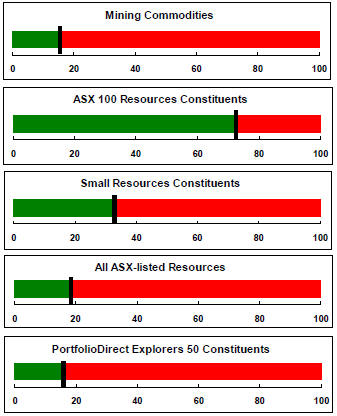
Equity Markets
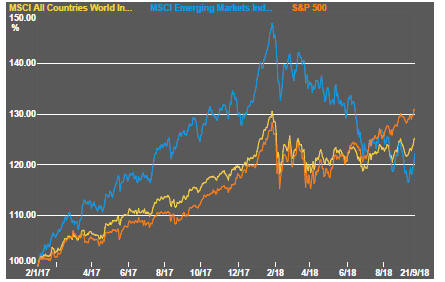

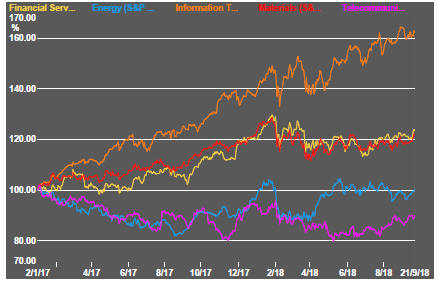
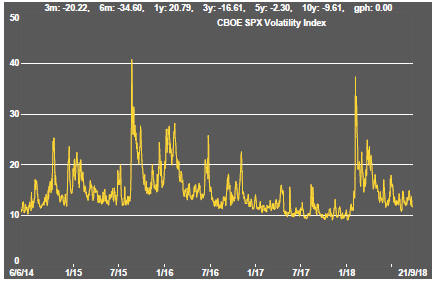
Equity markets were generally higher as anxieties over trade policies diminished and, among developing economy markets, fears over slumping exchange rates subsided.
The lower risk outlook translated into demand for cyclical stocks with Caterpillar, for example, posting the largest gains among the stocks in the Dow Jones Industrial Index.
Trade policy issues seem no closer to resolution but investors appeared to downgrade their importance even as Walmart, the world’s largest retailer, complained to the US government about the impact of its policies.
The US administration moved ahead with plans to place tariffs on a larger range of goods imported from China, as it again warned against retaliation.
Equity investors appeared to have reconciled themselves to a further tightening in monetary policy in the upcoming meeting of the US Federal Reserve as they also shrugged off the impact of higher US government bond yields.
Resource Sector Equities
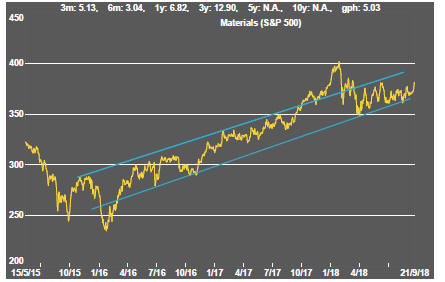
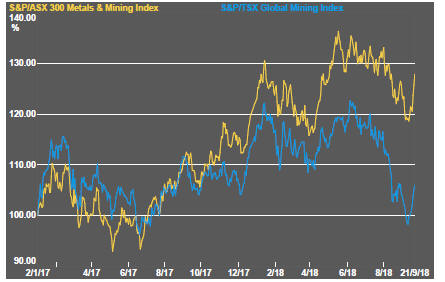

Mining stocks were buoyed by the renewed willingness to embrace risk among investors.
The market leaders made strong gains globally with the merger of Barrick Gold and Randgold adding to interest within the gold sector amid speculation about other potential takeover targets.
The smallest gains came among the smallest stocks in the sector which again have missed out on the upside from improved sentiment about macroeconomic conditions highlighting the thin base on which the recovery in mining equity prices over the past two weeks has been based.
Interest Rates


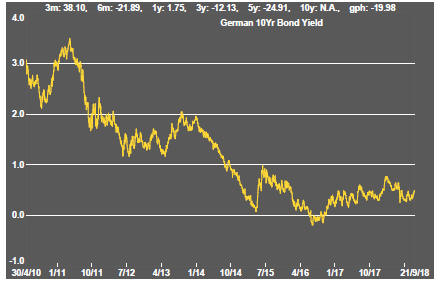

US government bond yields edged higher in anticipation of two interest rate rises by the US Federal Reserve during the balance of 2018 and amid evidence of inflation moving above the target of Federal Reserve policymakers.
Indicators of financial market conditions which might affect mining company debt costs did not change significantly.
Exchange Rates






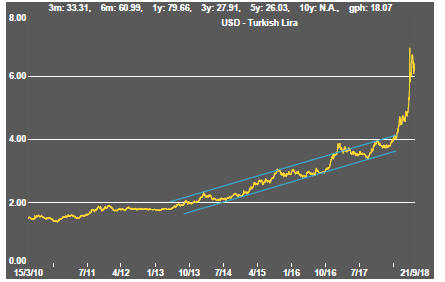



With a slightly more positive view about the attractiveness of risk assets, the US dollar moved lower (as other currencies were correspondingly higher). The more comfortable investors have begun to feel about global economic conditions, the weaker the US dollar has tended to be.
While developing economy currencies have stabilised, the structural problems which have recently driven them lower have not been addressed, leaving them at risk of continuing bouts of weakness, especially as the process of rising US interest rates is expected to continue throughout the remainder of 2018 and during the 2019.
Commodity Prices

The general upswing in commodity prices since mid 2017 had been given added impetus by stronger crude oil prices.
Diminished momentum has left prices within the bounds of a cyclical trough, albeit at the upper end.
The flip side of the benefits for commodity producers and exporters of higher commodity prices is the cost pressure now being experienced by users of agricultural and raw material commodities. Reporting companies have been suggesting this as a source of margin compression.
Business surveys closely watched by central banks are showing signs of upward pressure on selling prices as a result of higher raw material prices.
Gold & Precious Metals







Precious metal prices stabilised although rising US interest rates would be working against a more robust recovery. Lower government bond prices leave gold prices at risk of falling further despite already significant declines.
Palladium prices which had been dragged lower by macroeconomic forces also affecting gold, silver and platinum have shown a strong recovery, helped by the industrial orientation of the metal.
Gold related equity prices have been helped by the better sentiment within bullion markets as well as speculation about the possibility of heightened merger activity after the proposed combination of Barrick Gold and Randgold.
Nonferrous Metals



More favourable news about growth oriented investments helped metal prices.
Most of the daily traded nonferrous metals posted higher prices during the week. Tin and lead prices were lower. For the quarter as a whole, prices are set to have made large percentage losses.
The disparity between movements in copper prices and bond yields suggests a continuing tension between the views implied by the two indicators about the global growth outlook. The metal price suggests some pessimism about near term growth - at least suggesting that anticipated demand is going to be insufficient to keep soaking up incremental supplies.
Bulk Commodities

Chinese economic growth reports show the national economy meeting its targets, as one would expect for a centrally planned economy, but suggest it is only doing just enough. There are no signs of upside risk. The tariff fight with the USA is beginning to take a toll on activity rates in an economy with a bias toward less strong growth in the years ahead, in any event.
Higher steel prices have not been reflected in stronger iron ore price outcomes despite the improved profitability of the steelworks. Higher production is possibly in anticipation of more government construction stimulus to keep growth on target. There is also uncertainty about the extent of production curbs over the balance of 2018 as environmental restrictions on production are implemented. .
Coal prices continue at high levels reflecting China’s drive to source cleaner energy and as constraints on new mine development keep a rein on supplies.
Oil and Gas
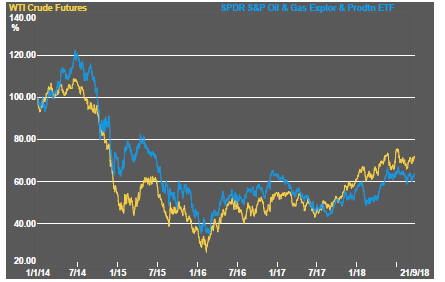
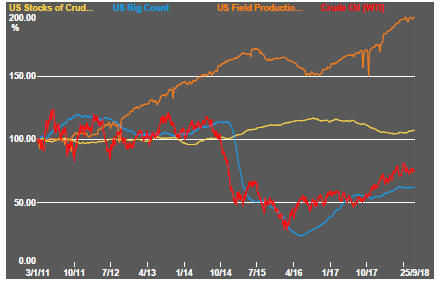
The upward trend in crude oil prices has given way to a leveling out in price although the market did strengthen in the past week amid speculation about further price rises as President Trump continues to complain about OPEC refusing to keep a lid on prices.
OPEC production decisions have helped to support prices as has reimposition of economic sanctions by the US government on Iran. The failure of effective government in Venezuela has been another contributing influence.
The Iranians have been lobbying European countries to prevent more widespread application of sanctions but the likelihood of relief appears slim as long as funds must circulate through US banks.
US production, in any event, continues to rise and is now matching output from Russia and Saudi Arabia. Texas alone is positioned to be the third largest producer after Russia and Saudi Arabia. Export infrastructure limitations may be the greatest impediment to US production having a greater effect on international energy prices.
Despite the change in tone within crude oil markets, related equity prices have been muted in their responses, implicitly signaling scepticsm about the sustainability of price rises when they have occurred.
Battery Metals


Eighteen months of rising lithium-related stock prices have given way to a prolonged period of market reassessment as a lengthy pipeline of potential new projects has raised the prospect of ongoing supplies better matching expected needs.
Potential lithium producers have been able to respond far more quickly to market signals than has been the case in other segments of the mining industry where development prospects have been slowed by reticence among financiers to back development.
Movements in lithium related equity prices had been aligned more closely with overall sector equity prices in recent weeks including the recovery in prices over the past week which has been particularly evident among the lithium exposed companies.

Battery metals remain a focal point for investors with recent attention moving to cobalt and vanadium.
Doubts about political conditions in the Democratic Republic of the Congo (and instances of Ebola) have added a dimension to cobalt prices lacking in other metals caught up in the excitement over the longer term impact of transport electrification.
In the longer term, cobalt is the most vulnerable of the battery related metals to substitution with high prices likely to stimulate research in that direction.
A spokesperson for Panasonic, manufacturer of batteries for Tesla motor vehicles, has been quoted as saying that the company intends to halve the cobalt content of its batteries because of uncertainties over supply although, offsetting such a move, will be the rapid increase in the number of units produced.
Uranium


The uranium sector is in the midst of forming a prolonged cyclical trough as market balances slowly improve. Power utilities are still not prepared to re-enter the market for contracted amounts of metal to meet longer term needs. A slight upward bias in prices has been evident in the past month.
Slightly higher equity prices from time to time, in the hope of improved conditions, have not been sustained but could be repeated as speculation about improved future demand ebbs and flows. The effect of an announcement by Canadian producer Cameco to extend the duration of its previously implemented production cut gave the market a very slight but quickly lost lift.

The Steak or Sizzle? blog LINK contains additional commentary on the best performed stocks in the sector and the extent to which their investment outcomes are underpinned by a strong enough value proposition to sustain the gains.


